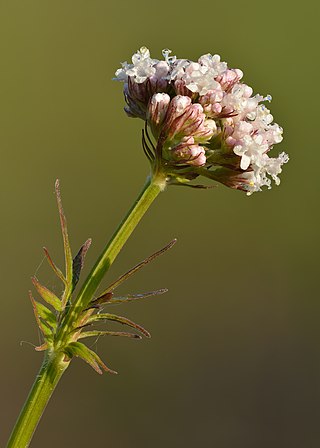
Valerian is a perennial flowering plant native to Europe and Asia. In the summer when the mature plant may have a height of 1.5 metres, it bears sweetly scented pink or white flowers that attract many fly species, especially hoverflies of the genus Eristalis. It is consumed as food by the larvae of some Lepidoptera species, including the grey pug.

Herbert James Elliott is a former Australian athlete and arguably the world's greatest middle distance runner of his era. In August 1958 he set the world record in the mile run, clocking 3:54.5, 2.7 seconds under the record held by Derek Ibbotson; later in the month he set the 1500 metres world record, running 3:36.0, 2.1 seconds under the record held by Stanislav Jungwirth. In the 1500 metres at the 1960 Rome Olympics, he won the gold medal and bettered his own world record with a time of 3:35.6.

Valeriana is a genus of flowering plants in the family Caprifoliaceae, members of which may by commonly known as valerians. It contains many species, including the garden valerian, Valeriana officinalis. Species are native to all continents except Antarctica, with centers of diversity in Eurasia and South America.
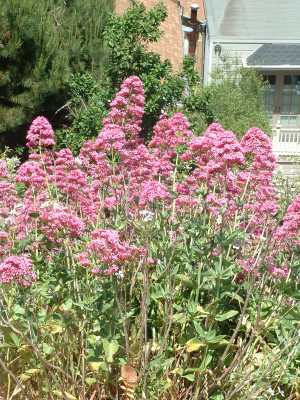
Valeriana rubra, the red valerian, spur valerian, kiss-me-quick, fox's brush, devil's beard or Jupiter's beard, is a popular garden plant grown for its ornamental flowers.
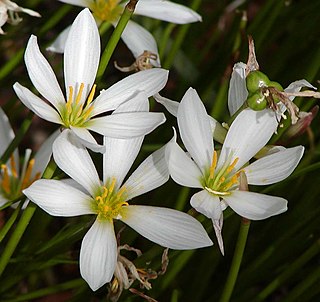
Zephyranthes is a genus of temperate and tropical bulbous plants in the Amaryllis family, subfamily Amaryllidoideae, native to the Americas and widely cultivated as ornamentals. Following the expansion of the genus in 2019, which now includes the genera Habranthus and Sprekelia, there are about 200 recognized species, as well as numerous hybrids and cultivars. Common names for species in this genus include fairy lily, rainflower, zephyr lily, magic lily, Atamasco lily, and rain lily.
Yanal Bog is a 1.6 hectare biological Site of Special Scientific Interest on the southern edge of the North Somerset Levels, just north of the village of Sandford, North Somerset. It was notified as an SSSI in 1988.
British NVC community MG2 is one of the mesotrophic grassland communities in the British National Vegetation Classification system.
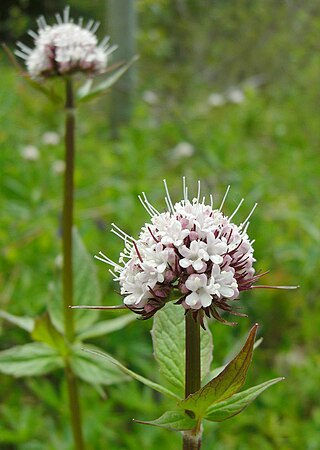
Valeriana sitchensis is a species of valerian known by the common name Sitka valerian. It is native to northwestern North America from Alaska and northern Canada to Montana to northern California, where it grows in many types of habitat, including moist mountain forests. In moist subalpine meadows, it is often one of the most common plants. This is a rhizomatous perennial herb producing a stout, erect stem to about 70 centimeters in maximum height, but known to exceed one meter at times. The leaves vary in size and shape, often having deep lobes or being composed of several leaflets. The inflorescence is a cyme of many white or pink-tinged flowers, each under a centimeter wide. The flower has five corolla lobes and three whiskery stamens protruding from the center.

In general use, herbs are a widely distributed and widespread group of plants, excluding vegetables and other plants consumed for macronutrients, with savory or aromatic properties that are used for flavoring and garnishing food, for medicinal purposes, or for fragrances. Culinary use typically distinguishes herbs from spices. Herbs generally refers to the leafy green or flowering parts of a plant, while spices are usually dried and produced from other parts of the plant, including seeds, bark, roots and fruits.

Valeriana celtica is a species of plant in the family Caprifoliaceae. It is also known as Alpine valerian and valerian spikenard. It is endemic to the Eastern Alps and to the Graian and Pennine Alps. It grows as a perennial herb 5 to 15 cm (2.0–5.9 in) tall. Along with Valeriana saxatilis and Valeriana elongata, it forms a clade of dioecious plants. Until the 1930s, it was extensively harvested for export to Asia for use in perfumes. The root has been used as a folk remedy as a nerve tonic.

Valeriana congesta, synonym Plectritis congesta, is a species of flowering plant in the honeysuckle family. It is known by several common names, including shortspur seablush and rosy plectritis. It is native to western North America.

Valeriana ciliosa is a species of flowering plant in the honeysuckle family known by the common name longspur seablush. It is native to western North America from Washington to Baja California and Arizona, where it is a common plant in mountains, valleys, and coastal habitats.

Valeriana macrocera is a species of flowering plant in the honeysuckle family known by the common names longhorn seablush and white plectritis. It is native to western North America from British Columbia to Montana to California, where it is a common plant in mountains, valleys, open steppe, and coastal habitat types. It is an annual herb growing erect to a maximum height between 60 and 80 centimeters. The widely spaced, paired and oppositely arranged leaves are oval or somewhat oblong, smooth-edged, and up to 4.5 centimeters long by 2 wide. The upper ones lack petioles. The inflorescence is a dense, cylindrical, headlike cluster of flowers in shades of pale pink to white. The corolla is under a centimeter long and is divided into five lobes and a short, blunt spur.
Redcar Field is a Site of Special Scientific Interest in the Darlington district of County Durham, England. It is situated just north of Darlington, about 1 km south of the village of Coatham Mundeville.

Valeriana occidentalis is a species of flowering plant in the honeysuckle family known by the common name western valerian. It is native to the western United States, particularly the northwestern quadrant, but it occurs as far south as Arizona and as far east as Colorado and South Dakota. It occurs in moist, forested mountain habitat. It is an erect herb growing 30 to 75 centimeters tall with whorls or opposite pairs of leaves at intervals along stem. The leaves are generally divided into lobes or are compound, with each leaf made up of a few oval-shaped leaflets. The inflorescence is a dense cyme of many funnel-shaped white flowers each 3 or 4 millimeters long with three long, protruding stamens. The fruit is a ribbed achene about half a centimeter long which may be tipped with the featherlike remains of the flower sepals.
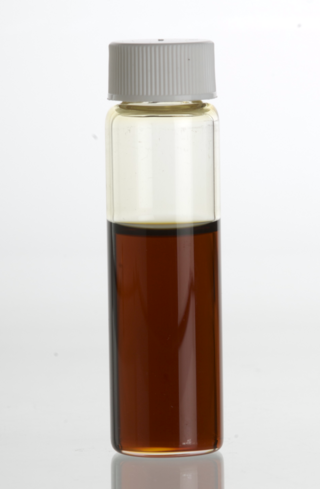
Spikenard, also called nard, nardin, and muskroot, is a class of aromatic amber-colored essential oil derived from Nardostachys jatamansi, a flowering plant in the honeysuckle family which grows in the Himalayas of Nepal, China, and India. The oil has been used over centuries as a perfume, a traditional medicine, or in religious ceremonies across a wide territory from India to Europe. Historically, the name nard has also referred to essential oils derived from other species including the closely related valerian genus, as well as Spanish lavender; these cheaper, more common plants have been used in perfume-making, and sometimes to adulterate true spikenard.

Valeriana jatamansi, formerly known as Valeriana wallichii, is a rhizome herb of the genus Valeriana and the family Valerianaceae also called Indian Valerian or Tagar-Ganthoda, not to be confused with ganthoda, the root of Indian long pepper. It is an herb useful in Ayurvedic medicine used as an analeptic, antispasmodic, carminative, sedative, stimulant, stomachic, and nervine.

Valeriana edulis, the tobacco root or edible valerian, a species of flowering plant in the family Caprifoliaceae, is a dioecious perennial herb native to western and central North America. Despite its common name, tobacco root is not closely related to tobacco, but is instead more closely related to elderberry, honeysuckle, and teasel.

Ledol is a poisonous sesquiterpene that can cause cramps, paralysis, and delirium. Caucasian peasants used Rhododendron plants for these effects in shamanistic rituals.
















